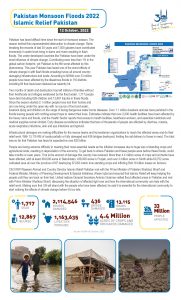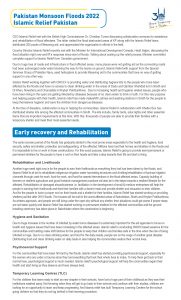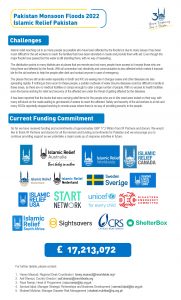Pakistan Monsoon Floods 2022 Islamic Relief Pakistan (12 October, 2022)
Source: Islamic Relief, reliefweb.int, Posted Date:13 Oct 2022




Report Link:
Pakistan has faced difficult time since the start of monsoon season. The reason behind this unprecedented destruction is climate change. Rains breaking the records of last 30 years and 7,000 glaciers have contributed immensely in water level rising in dams and rivers resulting in flash floods. The under developed countries like Pakistan have been under the most influence of climate change. Contributing even less than 1% in the global carbon footprint, yet Pakistan is the 8th worst affected by this phenomena. This year Pakistan has faced one of the worst effects of climate change in with flash floods wreaking havoc all around country damaging infrastructure and lands. According to NDMA over 33 million people have been affected by the disastrous floods in 116 districts including 84 that have been declared as calamity hit.
Two months of death and destruction has left millions of families without their livelihoods and villages swallowed by the flood water. 1,717 people have died including 639 children and 12,867 injuries in these floods.
Since the season started 2.1 million people have lost their homes and are now living under the open sky with no source of food and water, 1,717 DEAD 33 Million PEOPLE AFFECTED 12,867 INJURED 436 BRIDGE DAMAGED 13,115 ROADS DAMAGED 2,114,546 HOUSES DAMAGED 1,163,635 LIVESTOCK PERISHED livestock dying and children on the verge of facing dangerous water borne diseases. Over 1.1 million livestock animals have perished in the floods leaving people with nothing except hope to restart their lives. Estimates indicate that over 2,000 health facilities have been affected by the heavy rains and floods, and the Health Sector reports that access to health facilities, healthcare workers, and essential medicines and medical supplies remain limited. Early disease surveillance indicates that tens of thousands of people are affected by diarrhea, malaria, acute respiratory infections, skin and eye infections and typhoid.
Infrastructural damages are making difficulties for the rescue teams and humanitarian organizations to reach the affected areas and do their relief work. With 13,115 KM of roads partially or fully damaged and 436 bridges destroyed, limiting the aid delivery to those in need. The total loss so far that Pakistan has faced is expected be over $20 billion.
People are facing extreme difficulty in meeting their most essential needs as the inflation increases due to huge loss of standing crops and agricultural lands, resulting in depreciation of the economy. To get back to where Pakistan and these people were before these floods, could take months or even years. That is the amount of damage this country has received. More than 4.4 million acres of crops and orchards have been affected, with at least 304,000 acres in Balochistan, 438,000 acres in Punjab, and over 3 million acres in Sindh while 60,752 acres cultivated area all over the province of KP destroying 97,063 metric tons standing crops and inflicting Rs9.16 billion losses on farmers.
CEO IRW Waseem Ahmad and Country Director Islamic Relief Pakistan met with the Prime Minister of Pakistan Shahbaz Sharif and Federal Minister, Ministry of Planning Development & Special Initiatives, Ahsan Iqbal and ensured that Islamic Relief will keep helping the people until they are back on their feet. United nations General Secretary Antonio Guterres visited flood affected areas in Pakistan and met with Prime Minister Shahbaz Sharif, discussing the situation of affected right now and how the international community can help with the relief work. Making sure that UN will stand with the people who have been affected, he said it is essential for the international community to start noticing the effects of climate change before it’s too late.







